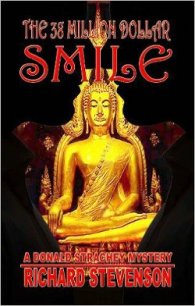Congo - Crichton Michael (книги регистрация онлайн бесплатно .TXT) 📗
Elliot recognized at once the most serious consequence of the speed-of-light weapons-they were much too fast for human comprehension. Men were accustomed to mechanized
warfare, but a future war would be a war of machines in a
startlingly new sense: machines would actually govern the moment-to-moment course of a conflict which lasted only minutes from start to finish.
In 1956, in the waning years of the strategic bomber, military thinkers imagined an all-out nuclear exchange lasting 12 hours. By 1963, ICBMs had shrunk the time course to 3 hours. By 1974, military theorists were predicting a war that lasted just 30 minutes, yet this “half-hour war” was vastly more complex than any earlier war in human history.
In the 1950s, if the Americans and the Russians launched all the bombers and rockets at the same moment, there would still be no more than 10,000 weapons in the air, attacking and counterattacking. Total weapons interaction events would peak at 15,000 in the second hour. This represented the impressive figure of 4 weapons interactions every second around the world.
But given diversified tactical warfare, the number of weapons and “systems elements” increased astronomically. Modern estimates imagined 400 million computers in the field, with total weapons interactions at more than 15 billion in the first half hour of war. This meant there would be 8 million weapons interactions every second, in a bewildering ultrafast conflict of aircraft, missiles; tanks, and ground troops.
Such a war was only manageable by machines; human response times were simply too slow. World War HI would not be a push-button war because as General Martin said, “It takes too long for a man to push the button-at least 1.8 seconds, which is an eternity in modem warfare.”
This fact created what Martin called the “rock problem.” Human responses were geologically slow, compared to a high-speed computer. “A modern computer performs 2,000,000 calculations in the time it takes a man to blink. Therefore, from the point of view of computers fighting the next war, human beings will be essentially fixed and unchanging elements, like rocks. Human wars have never lasted long enough to take into account the rate of geological change. In the future, computer wars will not last long enough to take into account the rate of human change.”
Since human beings responded too slowly, it was necessary for them to relinquish decision-making control of the war to the faster intelligence of computers. “In the coming war, we must abandon any hope of regulating the course of the conflict. If we decide to ‘run’ the war at human speed, we will almost surely lose, Our only hope is to put our trust in machines. This makes human judgment, human values, human thinking utterly superfluous. World War III will be war by proxy: a pure war of machines, over which we dare exert no influence for fear of so slowing the decision-making mechanism as to cause our defeat.” And the final, crucial transition-the transition from computers working at nanoseconds to computers working at picoseconds-was dependent on Type IIb diamonds.
Elliot was appalled by this prospect of turning control over to the creations of men.
Ross shrugged. “It’s inevitable,” she said. “In Olduvai Gorge in Tanzania, there are traces of a house two million years old. The hominid creature wasn’t satisfied with caves and other natural shelters; he created his own accommodations. Men have always altered the natural world to suit their purposes.”
“But you can’t give up control,” Elliot said.
“We’ve been doing it for centuries,” Ross said. “What’s a domesticated animal-or a pocket calculator-except an attempt to give up control? We don’t want to plow fields or do square roots so we turn the job over to some other intelligence, which we’ve trained or bred or created.”
“But you can’t let your creations take over.”
“We’ve been doing it for centuries,” Ross repeated. “Look: even if we refused to develop faster computers, the Russians would. They’d be in Zaire right now looking for diamonds, if the Chinese weren’t keeping them out. You can’t stop technological advances. As soon as we know something is possible, we have to carry it out.”
“No,” Elliot said. “We can make our own decisions. I won’t be a part of this.”
“Then leave,” she said. “The Congo’s no place for academics, anyway.”
She began unpacking her rucksack, taking out a series of white ceramic cones, and a number of small boxes with antennae. She attached a box to each ceramic cone, then entered the first tunnel, placed the cones flat against the walls, moving deeper into darkness.
Peter not happy Peter.
“No,” Elliot said. Why not happy’
“It’s hard to explain, Amy,” he said.
Peter tell Amy good gorilla.
“I know, Amy.”
Karen Ross emerged from one tunnel, and disappeared into the second. Elliot saw the glow of her flashlight as she placed the cones, and then she was hidden from view.
Munro came out into the sunlight, his pockets bulging with diamonds. “Where’s Ross?”
“In the tunnels.”
“Doing what?”
“Some kind of explosive test, looks like.” Elliot gestured to the three remaining ceramic cones on the ground near her pack.
Munro picked up one cone, and turned it over. “Do you know what these are?” he asked.
Elliot shook his head.
“They’re RCs,” Munro said, “and she’s out of her mind to place them here. She could blow the whole place apart.”
Resonant conventionals, or RCs, were timed explosives, a potent marriage of microelectronic and explosive technology. “We used RCs two years ago on bridges in Angola,”
Munro explained. “Properly sequenced, six ounces of explosive can bring down fifty tons of braced structural steel. You need one of those sensors”-he gestured to a control box lying near her pack-”which monitors shock waves from the early charges, and detonates the later charges in the timed sequence to set up resonating waves which literally shake the structure to pieces. Very impressive to see it happen.” Munro glanced up at Mukenko, smoking above them.
At that moment, Ross emerged from the tunnel, all smiles. “We’ll soon have our answers,” she said.
“Answers?”
“About the extent of the kimberlite deposits. I’ve set twelve seismic charges, which is enough to give us definitive readings.”
“You’ve set twelve resonant charges,” Munro said.
“Well, they’re all I brought. We’ve got to make do.”
“They’ll do,” Munro said. “Perhaps too well. That volcano”-he pointed upwards-”is in an eruptive phase.”
“I’ve placed a total of eight hundred grams of explosive,” Ross said. “That’s less than a pound and a half. It can’t make the slightest difference.”
“Let’s not find out.”
Elliot listened to their argument with mixed feelings. On the face of it, Munro’s objections seemed absurd-a few trivial explosive charges, however timed, could not possibly
trigger a volcanic eruption. It was ridiculous; Elliot wondered why Munro was so adamant about the dangers. It was almost as if Munro knew something that Elliot and Ross did not-and could not even imagine.


![[Magazine 1968-012] - The Million Monsters Affair - Davis Robert Hart (серия книг .txt) 📗](/uploads/posts/books/56864/56864.jpg)

